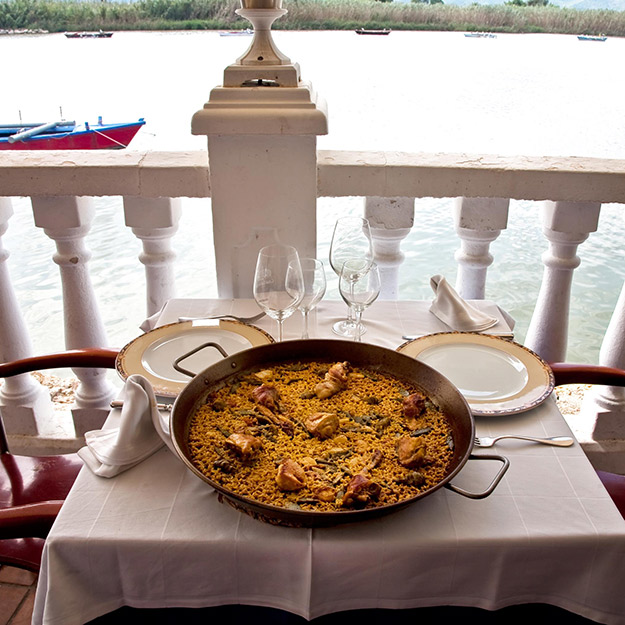.png.transform/rendition-xs/image_image%20(1).png)
Five Things to Know About Authentic Paella
What is a paellera? What goes into a true Paella Valenciana? What kind of rice should be used? If your answer to any of these questions about one of Spain's most famous and iconic dishes is “I don't know,” then we can help!
Text: Adrienne Smith/©ICEX

Go anywhere in the world and mention Spanish cuisine and the chances are fairly good that the first word that pops out of the other person's mouth will be “paella.” After all, this emblematic Spanish dish is certainly one of the greatest ambassadors for this country’s gastronomy. In fact, in 2015, paella was the fourth most searched-for dish on the internet, and Google searches for the word “paella” increased by nearly 48% in 2017 alone, totaling some eight million searches a year spread across the globe, according to a study carried out by the Escuela de Arroces y Paella Valenciana in conjunction with the company Original Paella.
But aside from these statistics, there are other important facts about this beloved Spanish dish that paella lovers around the world should know before enjoying (or preparing) paella. Here are five things to get you started on your way to becoming a paella expert:
1. Paella, paellera, paellero... it’s all about the pan
The key to a good paella lies as much in the ingredients as in the pan used for cooking it – essentially a round pan with low sides, two loop handles and a flat base. The word “paella” in fact derives from the Valencian name for the pan in which this rice dish is cooked – a word which in turn comes from the Latin word “patella” for pan. This can get somewhat confusing in the rest of Spain however, where the word “paellera” is more commonly (incorrectly) used for the pan, while “paella” is reserved for the dish itself. Then of course there is the word “paellero,” which refers to the person preparing this delicacy.
2. Paella Valenciana, as authentic as you get

The first region in Spain to cultivate rice, Valencia is considered the birthplace of rice cuisine in this country. Therefore it is not surprising that the best-known paella recipe is for Paella Valenciana, a dish that appeared for the first time in writing in an 18th-century manuscript. This iconic dish is made using rabbit and chicken pieces that have been sautéed to a golden brown in Spanish olive oil, combined with the native green bean varieties garrofón (big and flat lima beans), ferraúra (flat green beans) and tavella (like young, white kidney beans). Other important ingredients include saffron and pimentón, and snails are an optional (but frequent) inclusion.
3. To socarrat or not to socarrat
After cooking paella over a burner or an open fire (as opposed to an oven), there is often a layer of toasted, but not-burned rice at the bottom of the pan. The name for this toasty layer of goodness is socarrat. This is considered a delicacy by many, and as essential a part of a good paella as the ingredients themselves – although there are also those who prefer their paella without this toasted and crunchy bottom layer.Socarrat is considered such a culinary treasure by its fans that three-Michelin-starred Spanish chef Quique Dacosta, of Restaurante Quique Dacosta in Denia (Alicante), has elevated this toasted layer of rice to the level of avant-garde cuisine, creating an Arroz a banda “socarrat”, a thin sort of rice crêpe that represents what for many is the best part of the paella – and often the most difficult part to get just right.
4. Any old rice just won’t do

Rice has been cultivated in Spain for more than a thousand years. It was introduced to Europe by the Arabs who farmed it in the wetlands along the Spanish Mediterranean coast in the 8th century. It is important to use short, round-grained Spanish rice when making paella, which expands lengthwise as it cooks and absorbs a lot of liquid. Some of the most well-known varieties are Bomba, Balilla X Solana, Senia and Bahía, which are cultivated today in Protected Designation of Origins Calasparra (Murcia) and Arroz de Valencia – particularly in the Albufera wetlands of the latter – in addition to other areas of Spain.
5. Caldo, sofrito and other “secret” flavors
Yes, the type of rice is key, as are the ingredients, but paella wouldn't be paella without a good “fondo,” or base. This includes a flavorful, ideally homemade stock used in correct ratio to the rice, and a good sofrito. For authentic Paella Valenciana, however, usually only garlic and tomatoes are used, their aromas and flavors mingled with those of the saffron, pimentón and the occasional sprig of rosemary.
Anyway, do you need a perfect paella video recipe? Here you are! Canadian Chef Christine Cushing traveled to the birthplace of the original paella in Valencia (invited by ICEX-Foods & Wines from Spain and the Spain Trade Commission in Toronto) to learn how to make the authentic recipe for Paella Valenciana from a master at Restaurante Casa Salvador.


